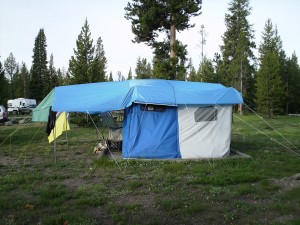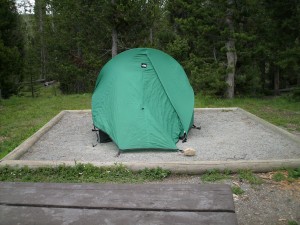How to Choose Camping Equipment
The type of equipment that you choose is going to have an impact or play a role in the quality of your camping experience. With good equipment, you will be able to focus on and enjoy the natural world around you; with bad equipment you will be more worried about your failing gear and perhaps your vacation will be ruined. With this in mind, we are going to cover how to choose camping equipment and which gear is the most important on a vacation.
The tent is the most important piece of camping gear! If you do not have a good tent and the wind is strong or there is heavy rain, the tent could fall down or leak. When this happens you will not sleep well (I have tried it), your sleeping bag will get wet and you will spend the following day drying out your gear. The best prevention is to buy a good tent with the following characteristics.
Aluminum Poles-These poles last a longer period of time in comparison to fiberglass poles. They are lighter weight than fiberglass and generally stronger in windy conditions. From my experience, repairs are more easily made on aluminum poles due to the fact that the stores that tend to sell tents with aluminum poles also tend to offer more services like repairs to clientele who buy their products. If you are unable to afford or just cannot find a tent with aluminum poles, fiberglass poles can and will serve you well. Additionally, fiberglass poles tend to be found on less expensive tents. Just don’t buy the cheapest tent on the market if you want some quality. If you need to repair a tentpole contact Tent Pole Technologies
Nylon Tent Ceiling-A tent with a nylon ceiling allows vapor from the occupants’ breath to pass through the ceiling where it collects on the rainfly. This moisture then runs down the rainfly to the ground outside the tent. If the ceiling material of the tent were not breathable, the water vapor would collect on the ceiling and then drip back down onto the tent occupants and make their sleeping bags wet.
Full Coverage Rainfly-A rainfly is the cover on top of the tent that keeps water out when it rains or snows. The benefits of a full coverage rainfly are that in stormy conditions it does a better job of keeping the moisture out of the tent and it allows the tent designer to use breathable ripstop nylon for the tent walls to help improve interior moisture management.
Waterproof or Taped Seams-Today, most tents come with a special adhesive tape running over the seams in order to keep water from working its way into the tent through the thread or needle holes along the tent floor and rainfly seams.
Waterproof Tent Floor-A waterproof tent floor is made of any fabric that prevents water from passing though it. There are many materials that are used for tent floors but the best is nylon covered with a waterproof coating. The reason for this is because nylon packs up much smaller when folding up your tent.
Screen or Netting Windows -A mesh or screen window helps prevent insect attacks and also helps ventilate the tent in the summer.
A Screen Door with a Nylon Window Shade-The screen door helps promote ventilation on warm days and nights. The nylon window cover or window shade offers privacy when changing and decreases ventilation when the air is cold.
If you purchase a tent with these characteristics, you a going to have a tent that will last many years thus saving you the money, time and hassle of buying another tent.
 Important Notes! When choosing a tent remember to take into account how much space you want or need. My recommendation is that family camping or base camping tents provide a minimum of 22 square feet per adult. This will allow the campers to use rectangular sleeping bags. If you are going backpacking, the rule of thumb for tent size is 15 to 20 square feet per person.
Important Notes! When choosing a tent remember to take into account how much space you want or need. My recommendation is that family camping or base camping tents provide a minimum of 22 square feet per adult. This will allow the campers to use rectangular sleeping bags. If you are going backpacking, the rule of thumb for tent size is 15 to 20 square feet per person.
Second, feel free to set up a tent before buying it. Sometimes they are hard to set up or require multiple people to set it up. Also, take off your shoes and get inside the tent to see if the space feels right for your needs.
Tent Care
When you finish a trip and return home, you must clean and dry your tent. To do this, set up your tent in the backyard and hose it off while wiping off any dirt or debris with a soft sponge. During this process you may use a diluted solution of mild soap and water. After you are finished washing the tent, leave it outside to dry in the sun. Make sure that the tent is staked out so it does not blow away and get damaged rolling down the street or into a fence. When the tent is completely dry, you can pack it up and put it away until your next trip. If the tent is not dry when it is packed up, it is going to grow mildew. Mildew makes the tent smell bad, causes ugly spots to form on the tent and it will destroy the waterproof coating on the tent floor and rainfly. Stop this problem before it starts by not storing the tent wet. Finally, do not place the tent in a washer or dryer! Both of these convenient household devices will destroy your tent!
Reality Check
Sometimes tents are stored wet and mold and mildew does grow on the tent. If this happens all may not be lost. Try the following procedure to see if it can help you recover your investment.
Using a wet sponge, rub the mildewing spots.
If the mildew remains, create a mixture of one cup Lysol with one gallon of hot water.
Place the sponge in this solution and rub it on the tent.
Now, leave the tent in the yard so it can dry out.
Finally, mix a cup of salt and a cup of lemon juice with a gallon of hot water. Using a sponge, place this solution on the mildewed parts of the tent and dry the tent another time. This solution is going to stop the growth of the mildew and help eliminate the bad odor but it is not going to remove the mildew stains on the tent.
Keeping house on the road
At the entrance of the tent, place a small rug or carpet. This carpet will help prevent the accumulation of dirt, small rocks and other things inside the tent. These small stones and other debris cause wear and tear on a tent floor and may puncture the floor of the tent where water will be able to enter during the next rain storm.
Another form of protection for the tent is to use a whisk broom and a dustpan to sweep the dirt and debris out of the tent. All tents accumulate dirt and debris and a whisk broom and dust pan are wonderful tools for helping keep the tent clean. Always clean the tent prior to packing it up for a new destination and if you remain in one location for a long time, sweep the tent from time to time.
Tent Storage
First when putting the tent away, make sure that it is very dry. If it is not, mildew will grow on the tent. Second, store the tent in a cool, dry place such as a closet in the home. Storing the tent in a hot garage or in a damp basement could promote deterioration of the waterproof coating or mildew growth. Third, it is fine to store the tent in the storage sack that came with the tent.


